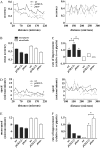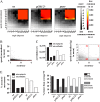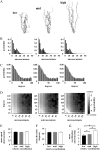3'-phosphoinositides regulate the coordination of speed and accuracy during chemotaxis
- PMID: 18676656
- PMCID: PMC2553113
- DOI: 10.1529/biophysj.108.130179
3'-phosphoinositides regulate the coordination of speed and accuracy during chemotaxis
Abstract
The PI3K/PTEN pathway, as the regulator of 3'-phosphoinositide (3'-PI) dynamics, has emerged as a key regulator of chemoattractant gradient sensing during chemotaxis in Dictyostelium and other cell types. Previous results have shown 3'-PIs to be important for regulating basal cell motility and sensing the direction and strength of the chemoattractant gradient. We examined the chemotaxis of wild-type cells and cells lacking PTEN or PI3K1 and 2 using analytical methods that allowed us to quantitatively discern differences between the genotype's ability to sense and efficiently respond to changes in gradient steepness during chemotaxis. We found that cells are capable of increasing their chemotactic accuracy and speed as they approach a micropipette in a manner that is dependent on the increasing strength of the concentration gradient and 3'-PI signaling. Further, our data show that 3'-PI signaling affects a cell's ability to coordinate speed and direction to increase chemotactic efficiency. Using to our knowledge a new measurement of chemotactic efficiency that reveals the degree of coordination between speed and accuracy, we found that cells also have the capacity to increase their chemotactic efficiency as they approach the micropipette. Like directional accuracy and speed, the increase in chemotactic efficiency of cells with increased gradient strength is sensitive to 3'-PI dysregulation. Our evidence suggests that receptor-driven 3'-PI signaling regulates the ability of a cell to capitalize on stronger directional inputs and minimize the effects of inaccurate turns to increase chemotactic efficiency.
Figures





Similar articles
-
Role of phosphatidylinositol 3-kinases in chemotaxis in Dictyostelium.J Biol Chem. 2007 Apr 20;282(16):11874-84. doi: 10.1074/jbc.M610984200. Epub 2007 Mar 1. J Biol Chem. 2007. PMID: 17331950
-
Distinct roles of PI(3,4,5)P3 during chemoattractant signaling in Dictyostelium: a quantitative in vivo analysis by inhibition of PI3-kinase.Mol Biol Cell. 2006 Apr;17(4):1503-13. doi: 10.1091/mbc.e05-09-0825. Epub 2006 Jan 18. Mol Biol Cell. 2006. PMID: 16421252 Free PMC article.
-
Intracellular encoding of spatiotemporal guidance cues in a self-organizing signaling system for chemotaxis in Dictyostelium cells.Biophys J. 2013 Nov 5;105(9):2199-209. doi: 10.1016/j.bpj.2013.09.024. Biophys J. 2013. PMID: 24209866 Free PMC article.
-
Directional sensing during chemotaxis.FEBS Lett. 2008 Jun 18;582(14):2075-85. doi: 10.1016/j.febslet.2008.04.035. Epub 2008 Apr 29. FEBS Lett. 2008. PMID: 18452713 Free PMC article. Review.
-
Signaling pathways at the leading edge of chemotaxing cells.J Muscle Res Cell Motil. 2002;23(7-8):773-9. doi: 10.1023/a:1024479728970. J Muscle Res Cell Motil. 2002. PMID: 12952075 Review.
Cited by
-
Cell speed, persistence and information transmission during signal relay and collective migration.J Cell Sci. 2010 May 15;123(Pt 10):1724-31. doi: 10.1242/jcs.060137. Epub 2010 Apr 27. J Cell Sci. 2010. PMID: 20427323 Free PMC article.
-
Ras, PI3K and mTORC2 - three's a crowd?J Cell Sci. 2020 Oct 8;133(19):jcs234930. doi: 10.1242/jcs.234930. J Cell Sci. 2020. PMID: 33033115 Free PMC article. Review.
-
Open access microfluidic device for the study of cell migration during chemotaxis.Integr Biol (Camb). 2010 Nov;2(11-12):648-58. doi: 10.1039/c0ib00110d. Epub 2010 Oct 15. Integr Biol (Camb). 2010. PMID: 20949221 Free PMC article.
-
The Genetic Background of Abnormalities in Metabolic Pathways of Phosphoinositides and Their Linkage with the Myotubular Myopathies, Neurodegenerative Disorders, and Carcinogenesis.Biomolecules. 2023 Oct 19;13(10):1550. doi: 10.3390/biom13101550. Biomolecules. 2023. PMID: 37892232 Free PMC article. Review.
-
A stochastic description of Dictyostelium chemotaxis.PLoS One. 2012;7(5):e37213. doi: 10.1371/journal.pone.0037213. Epub 2012 May 25. PLoS One. 2012. PMID: 22662138 Free PMC article.
References
-
- Iijima, M., and P. Devreotes. 2002. Tumor suppressor PTEN mediates sensing of chemoattractant gradients. Cell. 109:599–610. - PubMed
-
- Funamoto, S., R. Meili, S. Lee, L. Parry, and R. A. Firtel. 2002. Spatial and temporal regulation of 3-phosphoinositides by PI 3-kinase and PTEN mediates chemotaxis. Cell. 109:611–623. - PubMed
Publication types
MeSH terms
Substances
Grants and funding
LinkOut - more resources
Full Text Sources
Molecular Biology Databases
Research Materials
Miscellaneous

